人教版高中英语必修5Unit5语言点优秀教学设计
- 格式:pdf
- 大小:15.90 KB
- 文档页数:2
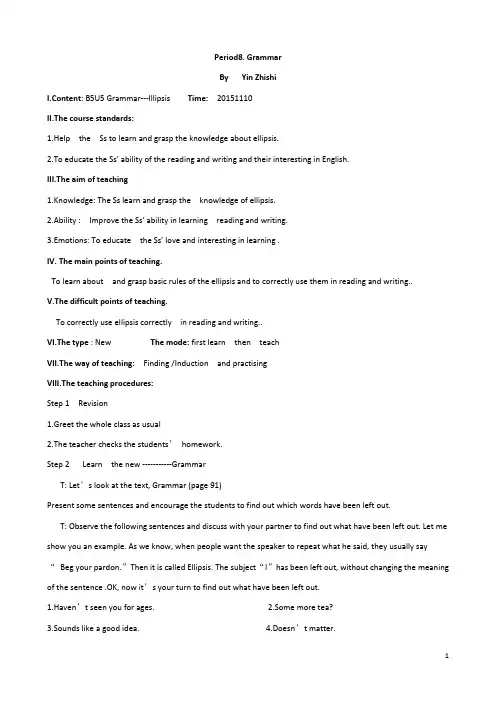
Period8. GrammarBy Yin ZhishiI.Content: B5U5 Grammar---Illipsis Time:20151110II.The course standards:1.Help the Ss to learn and grasp the knowledge about ellipsis.2.To educate the Ss’ ability of the reading and writing and their interesting in En glish.III.The aim of teaching1.Knowledge: The Ss learn and grasp the knowledge of ellipsis.2.Ability : Improve the Ss’ ability in learning reading and writing.3.Emotions: To educate the Ss’ love and interesting in learning .IV. The main points of teaching.To learn about and grasp basic rules of the ellipsis and to correctly use them in reading and writing..V.The difficult points of teaching.To correctly use ellipsis correctly in reading and writing..VI.The type : New The mode: first learn then teachVII.The way of teaching: Finding /Induction and practisingVIII.The teaching procedures:Step 1 Revision1.Greet the whole class as usual2.The teacher checks the students’homework.Step 2 Learn the new -----------GrammarT: Let’s look at the text, Grammar (page 91)Present some sentences and encourage the students to find out which words have been left out.T: Observe the following sentences and discuss with your partner to find out what have been left out. Let me show you an example. As we know, when people want the speaker to repeat what he said, they usually say “Beg your pardon.”Then it is called Ellipsis. The subject “I”has been left out, without changing the meaning of the sentence .OK, now it’s your turn to find out what have been left out.1.Haven’t seen you for ages.2.Some more tea?3.Sounds like a good idea.4.Doesn’t matter.5.Sorry to hear that.6.Pity you couldn’t come7.This way, please. 8.Terrible weather!9.Joining us for a drink? 10.Going to the supermarket?1.I haven’t seen you for ages.2.Would you like some more tea?3.That/It sounds like a good idea.4.It doesn’t matter.5.I’m sorry to hear that.6.It’s/ What pity you couldn’t come7.Step this way, please. 8.What terrible weather it is!9.Are you joining us for a drink? 10.Are you going to the supermarket?Step 3 PractisingDiscovering useful structures (page 37)1.In groups, look at these pairs of sentences. Discuss the difference between A and B in each pair. Also discuss which is the better sentence, A or B and Why.(page 37)2.Rewrite these sentences taking out the unnecessary parts.1)The burn that she got from the iron was red and ( it was )very painful2) A boy was on the left side of the sick woman, and a girl was on the right (side of the sick woman.)3)She has a daughter (who is) in hospital.4)He went to the doctor because he had to go to( the doctor).5)Did she pass the first aid test that she did yesterday (or didn’t she pass)?6)She could not decide whether to send him to hospital or not (to send him to hospital).7)When your nose is bleeding, you should bend forward so that the blood runs out of your nose and( the blood) doesn’t run down your throat.8)Only some of the students have done a first aid course but most of the students haven’t (done a first aid course).3.These sentences are correct. However, one or more words have been left out. Rewrite each sentence on the top of the next page to include the missing words.1)The cottage (that is) surrounded by a wall belongs to the local government.2)The first book I read this term was more interesting than the second (book I read this term).3)To her teacher’s surprise, she did better in her first aid exam than(it was) expected.4)I don’t think they have returned from the hospital, but they might have ( returned from the hospital).5)He wanted to help the accident victim but his friend didn’t (want to help the accident victim).6)You can borrow my first aid notes if you want to (borrow my first aid notes).4.Show the students the slides with some multiple choices exercises about the Ellipsis.(If possible )1)---- Tomorrow is a holiday. Why are you doing your homework?-----I am doing these exercises now so that I won’t have _____ on Sunday.A. itB. themC. forD. to2)----Shall I invite Ann to my birthday party tomorrow evening?----Yes. It’ll be fine if you______. A. are B. can C. invite D. do3)---- Aren’t you the manager?-----No, and I______A.don’t want to B. don’t want to be C. don’t want be D. don’t want4)---- I’ll be away on a business trip. Would you mind looking after my cat?-----Not at all______.A. not to B. not to do C. not do it D. do not to5)----- Won’t you have another try?------ ________.A.Yes, I will have B. Yes, I won’t have C. Yes, I won’t D. Yes, I will6)-----I won’t do it any more.-----_______?A. Why not B. Why don’t do any more C. Why not do D. Why don’t 7)-----Do you think it will snow tomorrow?------______?A.I don’t think B. No, I don’t think C. I don’t think so D. No, I don’t so 8)-----Have you fed the cat?------No, but______.A. I’m B. I am C. I’m just going D. I’m just going toStep4 Sum upStep5 Homework:1. Go over the usage of Ellipsis.2. Finish listing structures on Page 71 Ex 1 and Ex 23. Prepare Reading and discussing on Page 38Thinkback:。
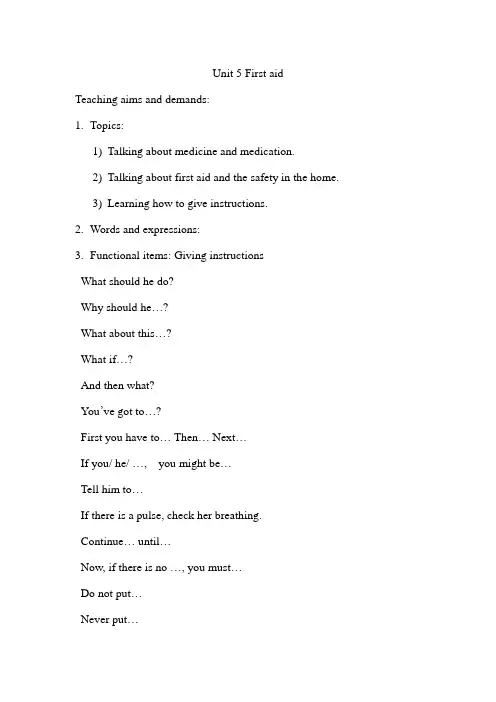
Unit 5 First aid Teaching aims and demands:1.Topics:1)Talking about medicine and medication.2)Talking about first aid and the safety in the home.3)Learning how to give instructions.2.Words and expressions:3.Functional items: Giving instructionsWhat should he do?Why should he…?What about this…?What if…?And then what?You’ve got to…?First you have to… Then… Next…If you/ he/ …, you might be…Tell him to…If there is a pulse, check her breathing. Continue… until…Now, if there is no …, you must…Do not put…Never put…4.Grammar use: EllipsisYou can get burnt by hot liquids and ( you can get burnt by) steam.First degree burns turn white when ( they are) pressed.Teaching procedures:Step One1.Ask students if they know what first aid is and why it is important.Then read the first paragraph of the section with students.2.Look at the pictures together and ask students what has happened ineach one.3.Put the class into groups of three or four and ask them to answer therest of the questions about the pictures.4.Bring the class together and ask students what kind of first aid youshould give in each situation. This should stimulate some interesting discussion as there might be some disagreement about first aid treatments.Step Two1.Ask students what has happened in the picture. (Answer: The child haspulled boiling water onto herself.) Ask students what sort of injuries the child will have. (Answer: She will have bad burns.) Ask the class what first aid treatment they would give in this situation. Don’t tellstudents whether they are right or wrong at this stage as they will find out from the reading text. Write all their suggestions on the board.2.Ask students to answer the questions about their own experiences ingroups. Bring the class together and ask various students about their or someone else’s experiences.Step Three1.First reading1)Ask students to read the title of the text and the headings within it.Then ask them what the topic of the text is and how theinformation is organized. (Answer: It is about first aid for burnsand the information is organized according to causes, types,characteristics and first aid treatment for burns.)2)Ask students how the information is organized within theheadings of types of burns and characteristics of burns. (Answer:The information is organized according to the types of burns: firstdegree, second degree and third degree burns.)。
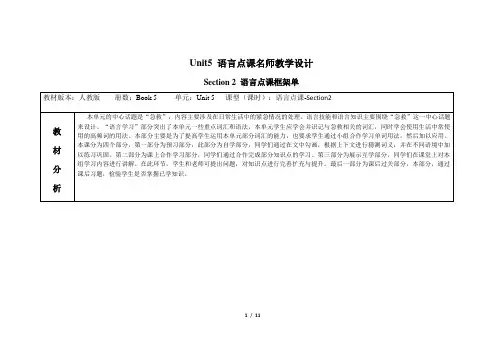
Unit5 语言点课名师教学设计Section 2 语言点课框架单1/ 112/ 113/ 11Section 2语法课教学设计步骤过程措施(教师活动与学生活动)目的持续性评价DELC 1预备与激活先期知识Step 1Leadingin(导入活动)(2 mins )T: Greetings……T: Today we will learn some words concerned with the topic of this unitfirst aid. At first, please underline the key words of this unit in the textFirst Aid for Burns and try to guess the meaning of each word in the textthrough context.1.Ask Ss to do exercise 1 to assist students understand the meaning ofeach words.Exercise One1.通过阅读课文,让学生在文中勾画出重点单词和词组。
然后让学生尝试根据上下文猜测词义。
2..通过单词和英文词义的配对,帮助同学们进行词义猜测与学习。
Key:HGBCAEDFJI1.学生是否能根据上下文猜测词义。
2.学生是否能通过上下文猜测词义。
4/ 113.通过在语境中的使用,加深学生对单词词义的理解。
Key:Vital/squeeze/unbearable/swell/electric/was affected/ essential/injuries/temporary/aids 3.学生是在不同语境是使用新单词。
DELC 2获取新知识Step 2Introduction andpresentation(引入和呈现)1.injury n. 损伤,受伤处injury-Injure v. ________-injured ___. _________He injured his left arm in a car accident.The doctor operated on the injured man at once.Man common ________ happen every day at home.injury/ wound/ hurt/ harmsThere were no injuries in the crash.The soldier received a bad leg wound in the war.It was a hurt that made me heartbroken.Studies show that smoking does harm to people.[Conclusion]1.injury 指的身体上的损伤,多指______ 中的受伤。
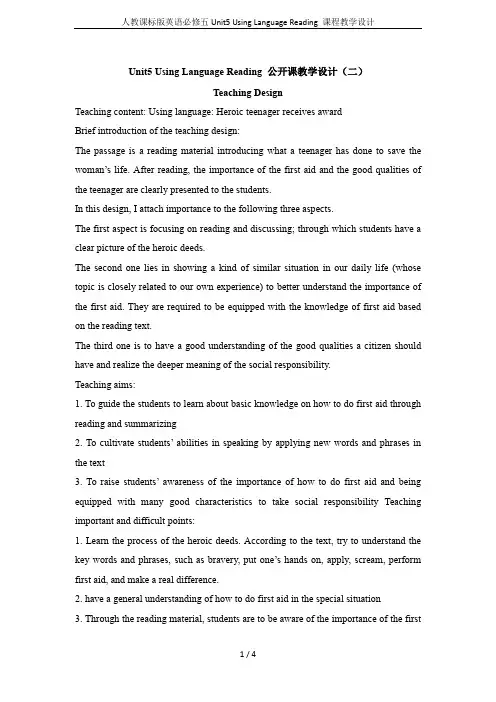
Unit5 Using Language Reading 公开课教学设计(二)Teaching DesignTeaching content: Using language: Heroic teenager receives awardBrief introduction of the teaching design:The passage is a reading material introducing what a teenager has done to save the woma n’s life. After reading, the importance of the first aid and the good qualities of the teenager are clearly presented to the students.In this design, I attach importance to the following three aspects.The first aspect is focusing on reading and discussing; through which students have a clear picture of the heroic deeds.The second one lies in showing a kind of similar situation in our daily life (whose topic is closely related to our own experience) to better understand the importance of the first aid. They are required to be equipped with the knowledge of first aid based on the reading text.The third one is to have a good understanding of the good qualities a citizen shouldhave and realize the deeper meaning of the social responsibility.Teaching aims:1. To guide the students to learn about basic knowledge on how to do first aid through reading and summarizing2. To cultivate students’ abilities in speaking by applying new words and phrases in the text3. To raise students’awareness of the importance of how to do first aid and being equipped with many good characteristics to take social responsibility Teaching important and difficult points:1. Learn the process of the heroic deeds. According to the text, try to understand the key words and phrases, such as bravery, put one’s hands on, apply, scream, perform first aid, and make a real difference.2. have a general understanding of how to do first aid in the special situation3. Through the reading material, students are to be aware of the importance of the firstaid and good qualities a qualified person should have.Teaching methods: task-oriented reading Teaching aids: multi-media and blackboard Teaching procedures: Greetings.This step is to shorten the distance with students and wish students were happy everyday. Finally, it is used to lead to the topic.Step1: Lead-inHave a talk with students about daily emergency and lead to the main character—a teenager. Invite students to enjoy a short video about a wonderful first aid performed by a professional doctor and ask them the following questions:Q1: What different kinds of emergency we may suffer in our daily life?A snake bite; bleeding; a sprained ankle; choking; a broken arm…Q2: At that time, what do we need?First aidQ3: Who can do the first aid well?A doctorQ4: Is he a good doctor? What kinds of qualities should a good doctor have? Yes; calm, patient, professional, experience, skilled, knowledgeable…The questions set are to lead to the leading character named John JansonT: Of course, a professional doctor can perform the first aid well. In fact, common people even a teenager can still do the first aid well.Step2: While-reading1. Ask students to listen to the record and find the answers to the following question. Q1: Where can you most probably read this passage?A. a novelB. a research paperC. a newspaper reportT: There is special structure in a piece of news.Paragraph 1 is the most important one which contains much important information. The step is set to help students better understand the structure of the news and get the important elements of the news.2. Ask students to read the text:1) Make a list of the elements contained in the news timelast night place In Rivertoncharacter A 17-year-old teenager, John Jansonevent He was honored at the Lifesaver Awards, for carrying out first aid on a neighbor named Anne Slade2). ①What happened to Anne?She was stabbed repeatedly…Her hands were almost cut off…T: We all know that Anne was saved by John finally.②What saved Anne’s life ?It was John’s quick action and knowledge of first aid that saved Ms Slade’s life.③Who also made their contributions to the rescue ?A number of nearby people his father④What first aid did John perform on Anne ?He slowed the bleeding by applying pressure to the wounds until the police and ambulance arrived.The design of this step is aimed at raising students’ awareness of the importance of the first aid in dangerous situation.3) Put the sentences into correct order__4__ The attacker ran away.__2__ Anne was attacked and started to scream.__6__ John performed first aid on Anne.__1__ John was studying in his house.__7__ The ambulance arrived.__3__ John ran outside with his father.__5__ John found Anne in her garden with terrible knife wounds.T: Though John has done the heroic deeds, he was still not so arrogant. What about his own feeling?We can learn it from his words. How to understand his words (para5)From his words, we can conclude that he is confident, modest, diligent, hard-working, serious-minded, and attentive.Official’s assessment: it shows that knowledge of first aid can make a real difference.Step 3. Post-reading1) Ask students to look back on the content and imagine:Q1: What impressed you most in the piece of news?The importance of first aid…His good qualities…T: This is a good result. Suppose the rescue is not so smooth…Some unexpected things:① The attacker was still at the scene of stabbing.② The attacker left but returned later.③ The woman had AIDS.④ John had performed first aid on the woman but she died anyway.Q2: Do you think John was silly or brave to get involved in the situation? Give reasons.This is designed to help students have a good imagination of the potential danger, in order to improve the figure of the teenager..Step 4. Group WorkPresent a similar situation in our daily life to the studentsHave a debate. Ask students to discuss what they will do in the following situation. The first purpose of the activity is to encourage students to be aware of the importance of saving others’ lives.Step 5. HomeworkChoose one of the ways of first aid to describeThis step aims to encourage students to gain the knowledge of first aid .The more, the better.。
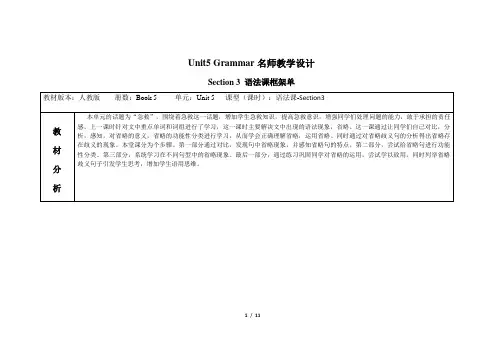
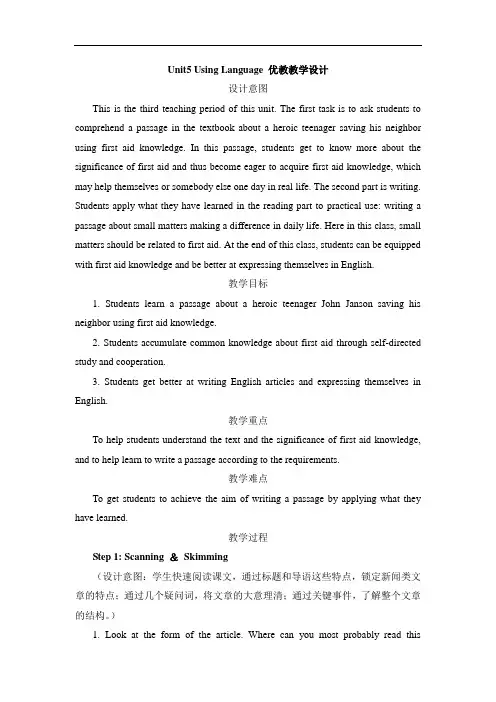
Unit5 Using Language 优教教学设计设计意图This is the third teaching period of this unit. The first task is to ask students to comprehend a passage in the textbook about a heroic teenager saving his neighbor using first aid knowledge. In this passage, students get to know more about the significance of first aid and thus become eager to acquire first aid knowledge, which may help themselves or somebody else one day in real life. The second part is writing. Students apply what they have learned in the reading part to practical use: writing a passage about small matters making a difference in daily life. Here in this class, small matters should be related to first aid. At the end of this class, students can be equipped with first aid knowledge and be better at expressing themselves in English.教学目标1. Students learn a passage about a heroic teenager John Janson saving his neighbor using first aid knowledge.2. Students accumulate common knowledge about first aid through self-directed study and cooperation.3. Students get better at writing English articles and expressing themselves in English.教学重点To help students understand the text and the significance of first aid knowledge, and to help learn to write a passage according to the requirements.教学难点To get students to achieve the aim of writing a passage by applying what they have learned.教学过程Step 1: Scanning &Skimming(设计意图:学生快速阅读课文,通过标题和导语这些特点,锁定新闻类文章的特点;通过几个疑问词,将文章的大意理清;通过关键事件,了解整个文章的结构。

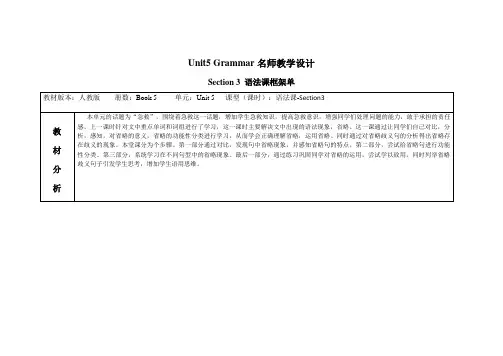
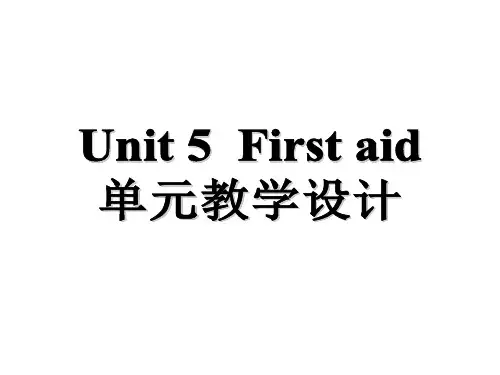
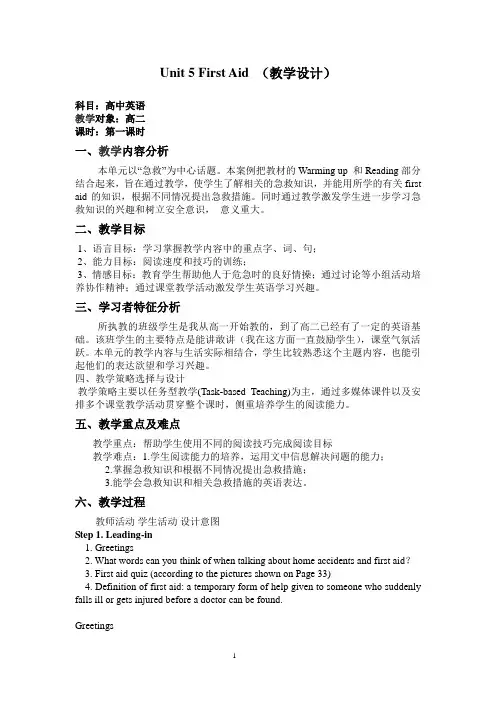
Unit 5 First Aid (教学设计)科目:高中英语教学对象:高二课时:第一课时一、教学内容分析本单元以“急救”为中心话题。
本案例把教材的Warming up 和Reading部分结合起来,旨在通过教学,使学生了解相关的急救知识,并能用所学的有关first aid的知识,根据不同情况提出急救措施。
同时通过教学激发学生进一步学习急救知识的兴趣和树立安全意识,意义重大。
二、教学目标1、语言目标:学习掌握教学内容中的重点字、词、句;2、能力目标:阅读速度和技巧的训练;3、情感目标:教育学生帮助他人于危急时的良好情操;通过讨论等小组活动培养协作精神;通过课堂教学活动激发学生英语学习兴趣。
三、学习者特征分析所执教的班级学生是我从高一开始教的,到了高二已经有了一定的英语基础。
该班学生的主要特点是能讲敢讲(我在这方面一直鼓励学生),课堂气氛活跃。
本单元的教学内容与生活实际相结合,学生比较熟悉这个主题内容,也能引起他们的表达欲望和学习兴趣。
四、教学策略选择与设计教学策略主要以任务型教学(Task-based Teaching)为主,通过多媒体课件以及安排多个课堂教学活动贯穿整个课时,侧重培养学生的阅读能力。
五、教学重点及难点教学重点:帮助学生使用不同的阅读技巧完成阅读目标教学难点:1.学生阅读能力的培养,运用文中信息解决问题的能力;2.掌握急救知识和根据不同情况提出急救措施;3.能学会急救知识和相关急救措施的英语表达。
六、教学过程教师活动学生活动设计意图Step 1. Leading-in1. Greetings2. What words can you think of when talking about home accidents and first aid?3. First aid quiz (according to the pictures shown on Page 33)4. Definition of first aid: a temporary form of help given to someone who suddenly falls ill or gets injured before a doctor can be found.GreetingsBrainstorming(cut, nosebleed, choking, burn...)Watch, read and think, then work in groups to make the choicesRead aloud and understand the definition通过问题自然引入本课内容日常急救知识小测试,使学生自然顺利进入新课学习让学生朗读理解定义Step 2. Pre-readingPresent the picture on Page 33 and ask the students to answer the questions of Pre-reading.Ask the students to look at the title and subtitle, and predict: What may be written in the text? Look at the picture carefully and discuss in groups. Choose one student to give the answers. (Answers can vary)Students look at the title and subtitle and give their prediction. 利用课文图片导入主题:FIRST AID FOR BURNS培养学生通过标题和小标题预测阅读内容的能力,也激发学生进一步阅读以验证预测。
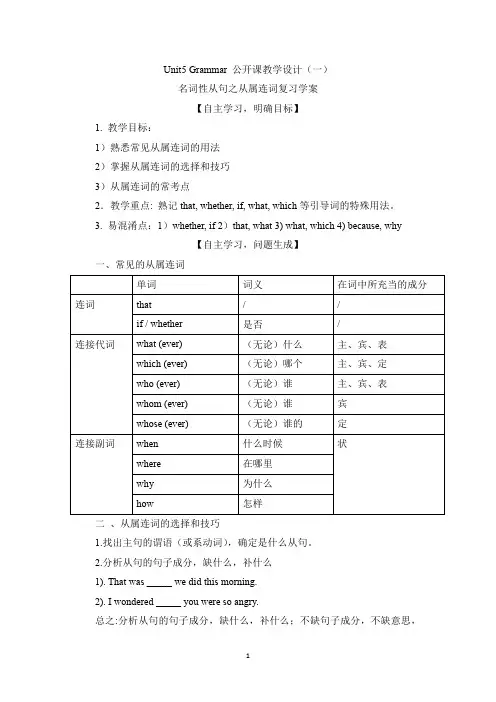
Unit5 Grammar 公开课教学设计(一)名词性从句之从属连词复习学案【自主学习,明确目标】1. 教学目标:1)熟悉常见从属连词的用法2)掌握从属连词的选择和技巧3)从属连词的常考点2.教学重点: 熟记that, whether, if, what, which等引导词的特殊用法。
3. 易混淆点:1)whether, if 2)that, what 3) what, which 4) because, why【自主学习,问题生成】一、常见的从属连词二、从属连词的选择和技巧1.找出主句的谓语(或系动词),确定是什么从句。
2.分析从句的句子成分,缺什么,补什么1). That was _____ we did this morning.2). I wondered _____ you were so angry.总之:分析从句的句子成分,缺什么,补什么;不缺句子成分,不缺意思,就选_______。
不缺句子成分,只缺“是否”,就选__________或if。
缺主语/宾语/表语,就选连接______词,如what, who, whom, which等;缺状语,就选连接_________词,如when, where, why, how等。
我的问题:(你在预习中有哪些未能解决的问题和有疑问的地方?写在下面做个备忘吧!等待课堂上与老师和同学他就讨论解决。
)三、名词性从句之从属连词常考点考点1:whether和if的选用1. I asked her __________ she had a bike.2. It is doubtful _________ he will come here.3. _____________ he will come is not clear.4. The question is __________ he’ll come.5. I haven’t decided _______ to go there.6. It all depends on ________ they will support us.7. I don’t know ________ or not he is well.8. I have no idea _________ the meeting will be put off.知识回顾:只能用whether, 不能用if引导的名词性从句:(1) 引导从句并在句首时;(2)引导___________从句和同位语从句;(3)引导_____词后的宾语从句;(4)从句后紧跟着_______时;(5) 后接不定式时, (whether to do );考点2:that 和what 的选用1. ______ he wants is encouragement.2. The fact is ______we have no time.3. Please tell me______ has happened to her.4. He is no longer _____he used to be.知识回顾: 1. that在名词性从句中_______任何成分,只起连接作用,即当从句是完整的也不缺任何意义时,就选that。
Unit5 Grammar 优教教学设计设计意图This is the last period of this unit, aiming to help students get a basic knowledge of the grammar “ellipsis” in this unit. The emphasis of this period is mainly placed on the understanding and the usage of the grammar. Therefore, teachers should create a relatively real context to present enough sentences to students to draw a conclusion about the rule of ellipsis. In the meantime teachers should offer more opportunities to students to practice using the grammar. Ellipsis is used in English to make our conversation simplified and neat, thus the learning of this grammar should not be too complex. Exercises designed for this purpose ought to be simple and easy to operate, which is connected with their daily life to make it easy to understand.教学目标1. Help students master the basic usage of ellipsis and know which parts of the sentences can be omitted.2. Students learn to use ellipsis in real situation through self-study and practice.3. Students get absorbed in English study and enjoy the beauty of English.教学重点The usage of ellipsis in English sentences.教学难点How to guide students to use ellipsis appropriately in real situations.教学过程Step 1: Lead-in(设计意图:学生观察句子,思考有哪些成分被省略,导入本课语法省略。
人教版高二英语必修五unit5教案例文整理老师要上好一节课,往往需花费十倍于它的或更多的时间作预备。
仔细写好教案是合格老师的基本功。
那么应当怎么写好教案呢?今日我在这里给大家共享一些有关于人教版高二英语必修五unit5教案最新例文,盼望可以关心到大家。
人教版高二英语必修五unit5教案最新例文4一.学情分析从同学高一理科期末考试状况来看,存在以下三方面问题:①在思想上、态度上放松或放弃的现象有所表露,读,不会读,就谈不上听得懂,看得懂,从而导致破罐子破摔的现象。
①基础学问不够扎实,敏捷运用语言的技能相对薄弱。
①运用力量不够强实。
同学的阅读力量、理解力量、分析力量、推断力量、应变力量等均不能较好地适应考查要求。
二.解决方法和详细工作1、仔细落实集体备课。
以集体备课为形式,集备课组全体的才智做好日常的教学工作。
详细做法如下:1、集体研讨,统一教学进度,教学目标,确定重点和难点;2、分工合作,收集备课资料,做到精选精练,突出应用与力量; 3》.整合教材,敏捷使用,变成实效性教材;4、摒弃不切实际的教学步骤,抓重点,搞强化,在日常教学中渗透语法意识。
2、利用教材提高同学的基本功,坚持默写单词及重点句型,培育同学的阅读力量,并以此材料为基础,扩充同学词汇量扩展同学阅读量,努力补充同学的词汇。
3、听力强化我们准备选用听力材料,作为日常听力训练。
4、综合检查1》预备每一单元做一次练习,主要以结合当前教学内容为主要测试内容,间或分块测试,习题的训练在于精而不在于多。
选择典型性题目,针对共性问题进行精讲。
2》在平常教学过程中不断扩高校生的词汇量,词汇教学以新带旧,从而达到巩固扩充词汇的目的,做到常常督促、检测。
总之,高二理科的教育教学工作任务虽然比较重,但是备课组的全体老师坚信只要我们团结全都,互研合作,虚心仔细,辛勤耕耘,追求科学方法,求真务实,优化教材资源,夯实“双基”,创新课堂教学模式,培育英语力量,我们的明天会更好!人教版高二英语必修五unit5教案最新例文5一、指导思想:在进一步明确了教学中应坚持的三个坚决即:以同学为主体,老师为主体,思维训联为主线。
Unit5 听说课公开课教学设计(一)Book5 Unit5 Period 4 Using languageTeaching Goals:1. To develop the Ss’ ability in reading, speaking, listening and writing.2. To get Ss to know more about first aid.Teaching Procedures:Step 1.Reading and comprehending1.WarmingUpPurpose: To lead Ss to the topic.Ask Ss to answer the following question. Let Ss speak their own mind and lead them to the reading passage.Question: if you happen to find a person who is bleeding badly, what will you do? 2. SkimmingPurpose: To make Ss have a brief understanding of this passage.Read the newspaper article by yourselves and then put the following events in the order that they happened._____ The attacker ran away._____ Anne was attacked and started to scream._____ John performed first aid on Anne._____ John was studying in his house._____ The ambulance arrived._____ John ran outside with his father._____ John found Anne in her garden with terrible knife wounds.Suggested Answers:4. 2. 6. 1. 7. 3. 53. Scanning and discussing.Purpose: To make the students find something in details. In groups discuss and answer the following questions.(1) What first aid did John perform on Anne?(2) What adjectives would you use to describe John’s actions? Give at least three.(3) Do you think John was silly or brave to get involved in the situation? Give yourreasons.(4) Would you have done the same as John? Give your reasons.(5) Do you think it is worthwhile to take a course in first aid? Give your reasons. Suggested Answers:(1) John dressed Anne’s injuries with tea towels and applied pressure to the wounds to slow the bleeding.(2) brave, heroic, courageous, quick-thinking, helpful, unselfish. Fearless, confident(3) Some possible answers:John was silly: he could have been attacked also, it was none of his business, the woman might have had AIDS.John was brave: he could have been attacked too, but he didn’t think about his one safety. All he thought about was how to help the victim.(4) Yes, I would do the same. Helping others who are in need is anyone’s responsibility.(5) Yes. Taking this course can make more people know how to perform the first aid. This would prevent more people from being worse injured.Step 2. ListeningPurpose: To develop the Ss’ listening ability.1.Pre-listening(1). Read these words and expressions and make sure Ss know the meaning of them: burning clothes, broken bones, bleeding, choking, snake bites, nose bleeds, bruising, sprained ankle.(2). Ask Ss what first aid treatment they would give in the situations in the list. Write their suggestions on the blackboard.2.While-listening(1) Circle the topics the teacher asks questions about in this listening text. Suggested Answers:nose bleeds, burning clothes, choking , sprained ankle, snake bite.(2) Match each of the following pictures with a topic listed in question(1) above.Suggested Answers:picture 1: sprained anklepicture 2: burning clothes picture 3: a nose bleedpicture 4: chokingStep 3. SpeakingAccording to the tape, discuss these questions in groups:1. Can you say the students' names on the tape?2. What can you tell us about Peter’s character?3. Can you remember any of the funny things he said?Suggested Answers:1. Sarah, Peter, Rachel, Jim, Gary.2. Stuart is the joker in the class/ the class clown/ the one who make s the others laugh.3. So he gets the blood all over the floor instead of on his clothes I'd say great--he's a terribleplayer anyway; Bite it back.Step 4. WritingWrite an article according to the following pictures and the first aid treatments you have learned in this unit.A woman lost consciousness and has stopped breathing. The pictures can direct you to help him breathing again? Write the measurements in details.One possible version:I will perform the first aid in eight steps. Before I do rescue breathing, the first, I will check whether the person is unconscious. Gently shake her by the shoulders. If she doesn’t respond, she’s unconscious. The second, I will put her in the recovery position. First place her arm straight out on the ground and bend her other arm across her chest. Bend the near leg up and then roll her away onto her side. Tilt her head backwards a bit so that any liquid can run out of her mouth and her tongue can fall forward. The third, I will check if the airway-the passage from the mouth to the lungs-is open. And then clear anything away from the inside of the mouth with my finger. The fourth, I will check if she can breath. See if her chest is rising and falling.Also I will place my cheek close to her face and listen and feel for air coming from the nose and mouth. If she is not breathing, I will have to start rescue breathing. This is the fifth step: roll her onto her back and squeeze her nose with my fingers to stop air coming out of it. I should place my mouth completely over the victim’s mouth and keep her head tilted and blow into her mouth for one and a half to two seconds. Watch her chest rise and then fall. Take another breath and blow into her mouth again. The sixth, I will check her pulse on the side of her neck. If there is a pulse, check her breathing. The seventh, if there is still no breathing, continue the rescue breathing at 15 breaths a minute. After about one minute, I will check the pulse and breathing again and continue this process until the victim begins to breathe on her own or medical help arrives. The last step, when she is breathing on her own again, I will put her in the recovery position.。
英语必修五unit5教案英语必修五unit5教案【篇一:高中英语必修五教案unit 5】新课标人教版英语必修5教案unit 5 firsr aid程洪维1. first aid is a temporary form help given to someone who suddenly falls ill or gets injured before a doctor can be found.give \ offer aid援助come to one’s aid 帮助某人cut off aid 终止援助a hearing aid 助听器teaching aids教具medical aid医疗救护with the aid of借助于in aid of为了帮助he fell ill and had to enter the hospital.他生病了必须住院治疗。
fall asleep睡着了fallsilent静下来the computer got damaged when we were moving.我的电脑在搬家时弄坏了。
my bike is getting repaired now.我的自行车正在修理。
my glass got broken while i was playing basketball。
我的眼镜在打篮球的时候给弄坏了。
peter and mary got married last year.皮特和玛丽去年接了婚。
2. you have three layers of skin which act as a barrier against diseases, poisons and the sun’s harmful rays.你有三层皮肤作为障来保护你免受疾病,毒药和有害光线的侵害。
barrier 名词,屏障,障碍物,隔阂you need to show the tickets at the barrier.你要在检票处出示你的票。
Unit5 Grammar 优教教学设计设计意图This is the last period of this unit, aiming to help students get a basic knowledge of the grammar “ellipsis” in this unit. The emphasis of this period is mainly placed on the understanding and the usage of the grammar. Therefore, teachers should create a relatively real context to present enough sentences to students to draw a conclusion about the rule of ellipsis. In the meantime teachers should offer more opportunities to students to practice using the grammar. Ellipsis is used in English to make our conversation simplified and neat, thus the learning of this grammar should not be too complex. Exercises designed for this purpose ought to be simple and easy to operate, which is connected with their daily life to make it easy to understand.教学目标1. Help students master the basic usage of ellipsis and know which parts of the sentences can be omitted.2. Students learn to use ellipsis in real situation through self-study and practice.3. Students get absorbed in English study and enjoy the beauty of English.教学重点The usage of ellipsis in English sentences.教学难点How to guide students to use ellipsis appropriately in real situations.教学过程Step 1: Lead-in(设计意图:学生观察句子,思考有哪些成分被省略,导入本课语法省略。
Unit5 语言点公开课教学设计教学设计内容设计者:福建省南平市高级中学林晓兰设计主题:整合复习必修五Unit 5 First aid词汇,培养学生语法填空能力整体设计思路、指导依据说明:2014年教育部考试中心启用了语篇型语法填空题来替代单项填空题,以测试考生运用语言进行交际的语用能力。
本题型语篇长度大约为200词左右,要求考生根据语境提示填写正确的词汇形式,考查考生领悟词汇和语法在不同语境中的运用与衔接。
通过对2014~2016年全国高考英语(课标卷Ⅰ)的研究,我们可以看出语篇型语法填空题一般以考查实词为主(大都给提示词),虚词为辅,比例大概在7:3左右。
该题型有以下特点:1)在语境中考查学生对语法基础知识的综合运用能力;2)体现功能语法的思想;3)关注语言结构与社会语境的关系;4)突出在具体的语言情景中通过语篇来实现语言的交际功能;5)实现语言知识、语言结构与语言意义的整合。
基于以上特点考虑,应对该题型应该从以下三个层面考虑。
首先,应该树立基于语篇的教学观,语言教学应该从关注语言结构上升为关注语篇的层面。
其次,在教学中应对基础的语法知识进行更加全面且有针对性的传授,开展语篇层面的微技能训练,引导考生将语法及词汇基础知识与语篇所产生的语境和语篇的交际目的结合起来,努力提高学生在语篇中运用语法的能力。
再者,教师可以将阅读教学与语法知识教学相结合;可利用课内外阅读文本,鼓励学生自主挖空、设题。
因此,本节课以必修五Unit 5 First aid为话题线索, 通过整合课文的语篇文本,复习单元重点词汇及内容,由点及面,由句到篇,层层递进;同时,以语法填空的考点为另一条线索,引导学生在观看视频和听力理解的过程中关注语言知识,培养语法意识,逐渐培养并提高语法填空能力。
教学内容和学生情况分析:本节课的复习载体是必修五Unit 5 First aid。
本单元话题为学生所熟知,学生对本单元词汇也有了一定的了解,因此复习起来难度不大。